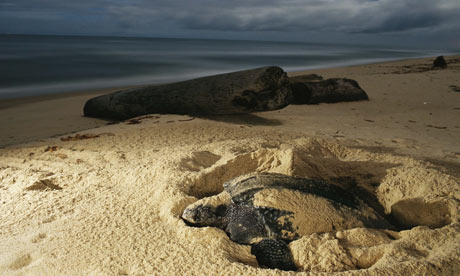
Editorial from the New York Times
Gorillas and Now Leatherbacks
Published: May 21, 2009
Last year, scientists were surprised to discover a large population of western lowland gorillas, a species close to extinction, in northern Congo Republic. Now there is news of another extraordinary find. In a multi-year survey of nesting sites along the coast of Gabon, scientists have found a startling number of leatherback turtles, possibly as many as 40,000, enough perhaps to remove leatherbacks from the list of globally endangered species. This is very good news, especially coupled with the fact that most of the nesting sites were discovered within protected areas.
In both cases, these new populations were located by conducting surveys in regions that had not been thoroughly combed before. Beyond relief, they remind us of what scientists felt in much earlier times, when explorers routinely chronicled the biological largess this world had to offer. Wonder was the predominant note in their chronicles, but there was also a keen eye for economic potential. Behind it all was the feeling of plenitude, that the biological riches of this planet were essentially inexhaustible, no matter what human beings did. That was clearly and tragically wrong.
Which brings us back to sea turtles and gorillas. We've grown accustomed to very different kinds of surveys, like the recent one showing that chimpanzee populations had dropped by 90 percent in Ivory Coast, which was supposed to be a stronghold for the species. In a very real sense, we are still exploring the planet, gradually obtaining a more realistic census of what life looks like in the early 21st century. Now and then there will be good surprises, like the fact that as many as 40,000 leatherbacks are nesting in Gabon. But the question those good surprises ultimately raise is a simple one: for how long?
An original article on the discovery of 40,000 leatherback turtles can be found at the guardian online







No comments:
Post a Comment